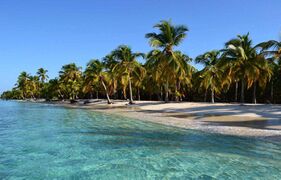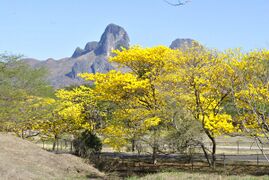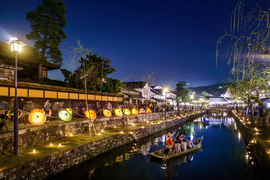Ogonkai
Council of Ogonkai 黄金海参事会 (Ogonkai-sanjikai) | |
|---|---|
Motto: 一致団結 ("Solidarity") | |
Anthem: 十二黄金海波 ("Twelve golden waves") | |
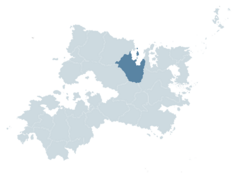 Location of Ogonkai (dark blue) In Audonia (light blue) | |
| Capital | None (de jure) Kinhara (de facto)[1] |
| Largest city | Minakyo |
| Official languages | Ogonkaic |
| Ethnic groups | Ogonkaic, Daxian |
| Religion |
|
| Demonym(s) | Ogonkan, Ogonkaic |
| Government | Federal directorial republic |
• Representative of Seiha Prefecture | Kouno Kagetori |
• Representative of Fujisato Prefecture | Hori Hidetaka |
• Representative of Shimakoshi Prefecture | Inagaki Katsunaga |
• Representative of Okusen Prefecture | Aso Tadamasa |
• Representative of Kisore Prefecture | Wada Koreyori |
• Representative of Narazaki Prefecture | Sukeko Morikawa |
• Representative of Ryokuya Prefecture | Sugawara Suekata |
• Representative of Kaibe Prefecture | Matsura Yokitoshi |
• Representative of Kinhara Prefecture | Osa Ishimaki |
• Representative of Iwanobe Prefecture | Suko Kanamaru |
• Representative of Hakusan Prefecture | Urakami Ietada |
• Representative of Fukugan Prefecture | Niiro Arimichi |
| Establishment | |
• As the Golden Sea States | 991-1581 |
• As the Council of Ogonkai | 17 November 1690 |
• Current Charter | 1 December 1974 |
| Area | |
• Total | 1,303,126.62 km2 (503,140.00 sq mi) |
| Population | |
• 2035 estimate | 64,849,014 |
| GDP (nominal) | 2023 estimate |
• Total | $3.011 trillion |
• Per capita | $46.430 |
| Gini (2022) | high |
| Currency | Chyo (Ȼ) |
| Driving side | right |
Ogonkai, officially the Council of Ogonkai or the Ogonkaic Council, is a country in northern Audonia. To the west and south, it is bordered by Jazee, Kandara and Ankivara. To the east, it is bordered by Wonjin and Ugioh. With a population of 64 million, It comprises an area of 1,303,126km2 (503,104 sq mi) spread among its main continental landmass and hundreds of islands.
Lacking a federal capital, the National Council meets in the historic city of Kinhara. Minakyo is the nation's most populated city with an estimated population of six million; other major hubs include Aoyama, Kinhara, Yamatake and Sugihara. Divided among 12 prefectures and 3 special territories, roughly half of the nation's territory is extremely mountainous, concentrating its highly urbanized population and robust industry to its coastal areas and major islands.
While the territory that now comprises Ogonkai has historically been sparsely settled with major population centers instead concentrating south in Daxia and its neighboring territories, the first of many migrations towards the territory commenced roughly 13,000 years ago. Millennia later, as a way to defend against the increasingly more common Myanga Ayil Khanate incursions throughout the region, the villages and small fiefdoms that dotted the territory began crystallizing into their own independent kingdoms in the late tenth century. Following a brief period of unified control from the city of Kinhara, the twelve kingdoms returned to being separate entities ruled by their own local lords until first contact with the Carto-Pelaxian Commonwealth forced the kingdoms into unification. The Charter of Unity was signed by the lords of the twelve realms in 1690 and was followed by an economic and population boom, consolidation of a newly-established upper class, forming of a cohesive national identity, and voluminous trade with both the Commonwealth and emerging Tierradorian trading companies.
After the dissolution of the Commonwealth, Ogonkai instaurated a policy of national self-reliance, termed "jishukoku", avoiding the conflicts that rocked the world at the time that lasted up to the start of the First Great War. The end of the period of isolation was followed by rapid modernization and staunch neutrality in the First and Second great wars. The rapid post-war economic boom precipitated a series of violent anti-monarchic riots that in 1974 culminated in the Rentai Revolution, resulting in the replacement of the Charter of Unity with the current Chart of Solidarity that has remained in effect ever since.
Presently, Ogonkai is a federal directorial republic, in which the power to create laws and administrate the country is jointly exercised by the representatives of the twelve prefectures (collectively the National Council). While Ogonkai boasts high standards of living and a vibrant, advanced economy fueled by the automobile, service, and electronics manufacturing industries, the nation struggles with high rates of inequality, discrimination (especially towards its non-ethnic Ogonkaic citizens), an stagnated political atmosphere and corruption. Internationally, Ogonkai is renowned for its global cultural footprint; Its globally influential culture is present in its pervasive animation, art, music and videogame industries, as well as an emerging robotics industry.
Etymology
The name for Ogonkai in the Ogonkaic language is written using the characters 黄金海. the characters "黄金", read "ogon", refer to gold, while the character "海", read "kai" refers to sea. Thus, the meaning of Ogonkai is "Golden Sea"; this is the source of the epithet "Land of the Golden Sea". Current consensus among historians establishes that this name was adopted during the brief spell of unification of the twelve kingdoms under the city of Kinhara, as the city shares the same characters (黄金).
Throughout the 17th century, the reading "Koganemi" was also used, but fell into disuse after the first contact with the Carto-Pelaxian Commonwealth; the explorers that came on the ships arrived at the sunset, and thus they called the land "Tierra del Mar Dorado" or "Terra do Mar Dorado".
Following contact with the Commonwealth, several newly-formed companies hailing from Tierrador established contact with the native population as well; in what is believed to be a mistranslation, the Tierradorian explorers mistakenly believed the name of the population to be "the Ogonkai", so they used the name "Apin Ogúúset" ("Far-away Ogonkan") to refer to its inhabitants.
History
First migrations and mass settlement (11,000 BCE - 991 CE)
The first settlements of Ogonkai are overwhelmingly located in the south-eastern parts of the country, indicating that the flow of population emanated from the much more populous Daxian regions. Several smaller currents arrived from present-day Kandara and Jazee, forming a second cultural group in the region. There are several indices of confrontation between these two groups, as archeologists have found human remains that are thousands of years old and with bones skewed by various weapons.
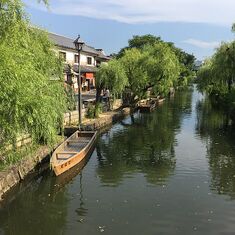
Broad trends across archeological sites indicate that by 200 CE the Kana people had been driven out of the disputed territories and retreated into the present-day Kandaran mountains, albeit small Kana villages survived in the Ogonkan mountains, becoming an isolated indigenous group, surviving to this day.
The first indices of civilization in the region take place in 501 CE, as a rich network of villages had sprung up throughout the coast and the Ishikari river located on the eastern side of the country. The fertile soils in this region allowed for rich harvests, which caused an explosion in population, although the rapidly developing western regions did not lag behind in development or population growth.
The regions to be inhabited last were the Home Islands (大島々; "Big islands"), with the first people to have settled all the three islands doing so as late as 600 CE. Nonetheless, due to their central location they quickly became a trade center in the region; commercial ties between the inhabitants of the islands and main island is believed to have started around 700 CE.
Formation of the twelve kingdoms and conflict with the Myanga Ayil Khanate (991 - 1581)
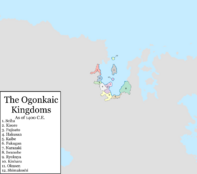
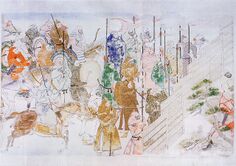
The increased trade and continuous back-and-forth migrations between the islands and regions of the mainland confounded the already high population growth and solidified the sea-based trade routes between the islands and the mainland, furthering the region's economic and technological prosperity. During this time, raids from the Myanga Ayil Khanate became more and more common and almost universally they were met with very little effective resistance, razing almost all of the villages that had settled far in land and massacring their inhabitants, effectively erasing them from the historical record.
This situation caused great chaos within the more developed coastal villages, sparking wars of self-preservation between local lords all throughout the region that culminated in the creation of twelve kingdoms that had arisen from this process of war.
By 1400 CE, the Khanate had reached the peak of its power, further strengthening the already common raids with more men and weapons. By this time, twelve kingdoms had been formed on the coasts of the region. The consolidation of these kingdoms allowed for a greater degree of societal organization, and the local kings soon began to mount armies to respond to the ever-increasing Khanate threat. The main places of combat were along the southern borders of the kingdoms of Narazaki, Fukugan and Hakusan, although significant engagements in kingdoms as far north as Iwanobe and Seiha were also reported.
While the southern kingdoms suffered many losses both in manpower and resources during this time, a tipping point in the Ogonkaic-Khanate Wars was the battle of Iwanobe, where the outnumbered kingdom managed to defeat the invading Khanate battallion by luring them into a river, ultimately causing their demise. News of the herculean achievement soon reached the lords of the other eleven kingdoms, invigorating their populations and revitalizing previously stagnant combat efforts.
By this time, the Kingdom of Kinhara was the richest of them all, thanks to its central location enabling commerce with all the other kingdoms. This accumulation of wealth resulted in great benefit, as it was able to leverage its economic weight to supply the other kingdoms with all the necessary materials to continue the war effort. Resources included gunpowder, food and metals, among others; this constant supply of materials both enabled the ever-weakening Khanate forces to be almost entirely driven out of the southern kingdoms by 1520 CE and significantly increased Kinhara's economic influence in the region, becoming an economic hegemon that more or less controlled the fate of the other kingdom's economies.
The downfall of the Myanga Ayil Khanate began in the 17th century, as much of their troops were demoralized and the upper ranks were consumed by corruption and frequent infighting. This instability brought an end to the Khanate invasions into the Ogonkaic kingdoms. However, taking notice of the widespread corruption within the ranks of the Khanate, emperor Teruyoshi of Kinhara bribed several Khanate battallions and bought their services with blocks of solid gold. This action virtually tripled Kinhara's combat strength and put it in a very favorable standing against the other kingdoms, battered and recovering from almost two centuries of constant war.
Kinhara-led unification of the twelve kingdoms (1602 - 1632)
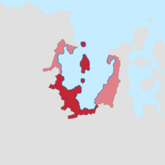
By the start of the 17th century, Kinhara had already begun incursions in all of the neighboring kingdoms, arguing that the debts the kingdoms assumed after purchasing supplies for the war efforts weren't being paid fast enough. While the kingdoms weren't able to put up any resistance, the battallions Kinhara had purchased the services of proved insufficient, as these troops were insufficiently trained in combat in the mountainous, forest regions that dominated the landscape. This incompetence significantly hindered Kinhara's momentum and, in the end, it was obligated to mount a force of its own to keep advancing.
As the southern kingdoms were in the process of being fully absorbed into Kinhara, the kingdoms of Seiha and Iwanobe negotiated favorable terms with Kinhara in exchange for sending troops to fight for it. Iwanobe and Seiha were allowed to keep a relative degree of independence, and they would be supplied with Kinharan men and weapons to conquer their respective northern regions, something both kingdoms had tried to do since the end of the war against the Khanate.
The last bastion of resistance was the kingdom of Hakusan that thanks to its mountainous geography was able to last a year longer before the walled city of Sugihara was finally overran, kickstarting the period of Kinhara rule over the former kingdoms.
The model of Kinharan domination of the former other kingdoms did not involve direct rule from Kinhara; rather, it involved a mix of intensification of trade between the former kingdoms and Kinhara, often to the disadvantage of the conquered territories, and the construction of a rich network of Kinharan operatives in each of the former kingdoms. Given the monopoly it had on trade throughout the region, most local lords and tradesmen buckled under the pressure and reluctantly accepted the new state of affairs.
Despite the fact Greater Kinhara had formed through conquest and economic dominance, this period of history was characterized by high cultural output. With the ever-looming Khanate threat gone, artistic expressions flourished. This period marked the creation of the foundations of what would eventually become Ogonkai proper, both in its societal expression and its cultural identity. Ogonkai's indigenous religion, worship of the golden god, became widespread throughout all of the former kingdoms at this time, thanks to Kinhara's influence.
Collapse of Greater Kinhara and last years of the kingdoms (1632 - 1690)
The downfall of Greater Kinhara began in 1620, with the formation of a secret group composed of disgruntled military lords, tradesmen and former nobility that had their societal standing and wealth uprooted by the Kinharan conquest. The group first met in the city of Minakyo, giving it its current historiographical name of the "Minakyo Group". The Minakyo Group covertly expanded its base of collaborators and informants to include all of the former kingdoms; among the ranks that had joined the Group there were local officials under control if Kinhara. This allowed the Group to siphon wealth and materials from Kinhara in preparation for its eventual uprising.
The vassal kingdoms of Seiha and Iwanobe, since their Kinhara-backed conquest of the northern regions, had been engaged in constant conflict with local indigenous lords and tribesmen. This forced Kinhara to divert funds and materials to those areas. Over time, this strain coupled with the silent siphoning of resources that had been happening for almost ten years diminished Kinhara's influence over the local lords, greatly wounding its system of control.

In 1631, Seiha experienced its first set of losses against the local tribes of the territory it had conquered. It requested more funds from Kinhara but it, Increasingly strained of resources, stopped supplying Seiha's war efforts. This enraged the upper class of Seiha that, aware of the existence of an insurrectionist group with roots all across the region, decided to covertly support by facilitating access to Kinharan funds and bribing Kinharan officials settled in Seiha. After this, Seiha envoys arrived in Iwanobe, which was losing its own conquered territory, as well. Following a lukewarm meeting between the envoys and the King of Iwanobe, the King of Seiha personally met with the King of Iwanobe and promptly secured his support.
The process that lead up to the Battle of Kinhara was a slow build-up of weapons and men from all of the former kingdoms that culminated in the 1633 Battle of Kinhara with chief participation of the King of Seiha, Shigeaki Ando, who acted as the commander. During this battle, more than 30,000 combatants are estimated to have participated; accurate figures are hard to determine given much of the documentation was destroyed by the Minakyo Group itself. Teruyoshi, seeing that the enemy forces had surrounded the city and were about to break into its walls, committed suicide.
After learning of the news, his son, now the new emperor, surrendered. The Battle of Kinhara assured the end of Greater Kinhara and kickstarted a new era of reconstruction within Kinhara proper and the solidification of previous ties that had been built during the lead-up to the battle. The Minakyo Group's leaders would go on to become influential political figures, serving as chief advisors to the different leaders of all the kingdoms. Despite losing a substantial part of its economic power, Kinhara rebuilt rather rapidly by the hand of the new emperor, who pursued a policy of peace in order to not erode away the centuries of wealth and influence the kingdom had built.
Following the battle, Seiha and Iwanobe would join Kinhara to become the region's economic motors as much of the trade that Kinhara previously monopolized was now going through those two kingdoms. However, unable to keep consistent control over the regions they had conquered, Seiha and Iwanobe relinquished their claims. The other kingdoms, now no longer reliant on Kinhara, also saw the development of their own trade networks and a greater degree of economic self-reliance.
Contact with the Commonwealth, unification, and modernization (1690 - 1795)
The first contact with outside powers occurred in 1690 with the arrival of the Carto-Pelaxians. They established mostly in Minakyo, and from there they built commercial and cultural ties. Following their arrival, emerging Tierradorian and Alstinian companies also settled. They introduced Occidental items and culture to the various kingdoms, as well as religion: the Chantric Church became the main Christian branch in Ogonkai, amassing around 100,000 believers. During this time, Occidental customs about society and governance were also introduced; Occidental books were translated, and from there a new field of study arised: 西学 (Yogaku), or Occidental studies. This nourished a generation of students, and in these circles, unification of the 12 kingdoms became a popular thought. Among these thinkers was Konitane Kitagaki, now considered the founding father of Ogonkai, who coined the following phrase that would become the motto of the emerging unification movement:
Naturally marching towards destruction, men kill each other if there are no other men they must unite against. Thus, it is the natural fate of all of the inhabitants of all the realms to engage in an endless war. To contain these destructive impulses, all men must unite into a single man on a social level; unity will bring the strength needed to overcome the trials that have been put forth by the hand of fate, and unity will halt the slow, creeping march towards oblivion.
Among the kingdoms, a new upper class was emerging. Those who traded with the outsiders saw their profits skyrocket and, consequently, their social standing improve significantly. These people made a living out of crafting uniquely "Ogonkaic" products to trade with the Occidentals, thereby sparking interest about Ogonkai within Carto-Pelaxia, Tierrador and Alstin, as well as forming an image of what "Ogonkai" looks like, helping further develop the emerging national identity. Another important aspect of culture that emerged during this era is the Ogonkaic pursuit of culture and entertainment: the enriched and newly consolidated upper class funded cultural pursuits as well as entertainment. Soon enough, the rapidly increasing middle classes began adopting this behavior as well, giving rise to modern Ogonkaic culture's emphasis on enjoyment and individual happiness.
This new upper class had a vested interest in unifying the country. To them, unification meant a standardized currency and standardized tariffs, both of which would be tremendously beneficial for their enterprises. The Occidental powers took notice of this, and Carto-Pelaxian soldiers disembarked all across the capitals of the twelve kingdoms, demanding they met in Kinhara to unify; the monarchs, displaced in power by the trading class, reluctantly accepted unification.
There were attempts by some to stop this unification. The King of Iwanobe, the only king that actively supported unification, was almost assassinated on several occasions, but nonetheless, the Charter of Unity was signed, establishing the Council of Ogonkai as a single state where each king ruled their own realm but deliberated with the others to decide the fate on all the kingdoms.
After the Charter was signed, Ogonkai rapidly westernized; a single currency, the Chyo, was created, thousands of kilometers of road were paved, and the population skyrocketed. The new Royal Council adopted a policy of westernization, mainly drawing from Alstinian and Carto-Pelaxian academics and scientists. The kings, with the influence of the Yogaku academics (many of whom served as high-ranking advisors) desired to make the new country stand as an equal to the Occidental powers, kickstarting the modernization of the army and purchase of tens of thousands of weapons to have an army that could stand up to Occidental standards.
The Industrial Revolution arrived to Ogonkai after it did to Alstinia and Carto-Pelaxia. At first, it resulted in a new boom in all fields and areas of industry. Soon after, however, the Commonwealth of Carto-Pelaxia collapsed, which put all economic activities on a halt that caused the first economic crisis in modern Ogonkaic history. This enraged the population, which perceived that the pursuit of trade with the Occidental powers above all else had made the country reliant on them. Facing increasing pressure from growing mass protests and threats of armed rebellion by parts of the military, the Royal Council decided in a 7-5 ruling to end the ongoing relationships between Ogonkai and the Occidental powers, expelling the vast majority of Occidental academics that had been brought in over the previous years. This virtually eliminated all Ogonkaic-Occidental relations, although a small group of Alstinians working in industry, the sciences and government were allowed to remain.
"Jishukoku" period and southwards expansion (1796 - 1896)
With the closing off of most relations with the Occident, the "Jishukoku" (自主国; lit. 'independent country') period began. As the new policy settled in, many inward-looking reforms during this time were enacted. Chiefly among them was the promulgation of an Alstin-inspired legal code that established 12 independent legal circuits and a Supreme Tribunal headquartered in Kinhara. During this era the modernization of the armed forces continued, with the ultimate goal of creating a military as strong as that of the Occidental nations. As industrialization continued, the urban middle class consolidated. Given that contact with Occidental culture continued through the small enclave of Alstinians in the city of Minakyo, cultural relations continued, and from the mixing of Occidental and Ogonkaic culture emerged a new class of popular writers.
These writers formed the People's Influence Bloc and, as more of the urban middle class joined, it swelled in size to become a significant organization. It began organizing protests across Ogonkai's major cities and industrial centers. At its peak, the Bloc rallied around 25.000 people spread out across the country (by this time, Ogonkai had around a million inhabitants). Mounting pressure on production centers forced the upper classes to back the protests, which forced the Royal Council to negotiate with the Bloc.
The result of these negotiations were the establishment of twelve Regional Councils that served the 12 regions. These councils were voted for directly by eligible voters, and they served an advisory role to each region's monarch. They could also veto any decisions made by the monarch if a 75% (9-3) majority within the Regional Council was reached. While this was an important step in modernizing Ogonkai's political system, the powers of the Regional Councils were limited; modeled somewhat after Alstin's own voting laws, only literate males above the age of 25 had the right to vote. This drastically skewed the voting pool in favor of the upper classes, perpetuating their influence in the political system. This remained a point of contention between the middle and upper classes throughout the century and was the motivation for many episodes of popular unrest and confrontation that would happen afterward.
As industrialization intensified, the nation's population continued to grow at an increasingly accelerated rate. Beginning in 1815, many resource shortages (including manufacturing components and food) were observed. In a 1819 9-3 Royal Council decision, it was decided that Ogonkai would pursue a policy of colonization over the yet unclaimed Southern lands with the stated purpose of "promoting an organized environment for urban expansion and extraction of resources to match the growing population". The first of such expansions happened in 1820, followed by successive expansions in 1832 and 1846. While an stated aim of the project was to lighten the load of urban centers by promoting settlement in these new lands, influx was minimal and by 1890 the Special Territories only had a population of 130,000 (3.25% of Ogonkai's 4 million citizens by the end of the century).
End of Jishukoku and role in the Great Wars (1896 - 1943)
The start of the First Great War marked the end of the end of the Jishukoku policy as the Royal Council voted in a 7-5 decision to end the policy of isolation. Originally, it was a 5-7 decision, but the Regional Councils of Ryokuya and Kaibe vetoed the votes and flipped the result. Almost immediately after this, the Great War started that saw a spike in demand of raw supplies, plentiful in the newly-colonized special territories. This confounded the growth of the industrial sector and motivated settlement further south, primarily by some of the first waves of Thervalan and Kandaran migrants to settle in Ogonkai. While the Royal Council publicly had a neutral position in the conflict and called for peace within the war's different actors, it covertly sold arms and resources to Cartadania, Pelaxia (on the side of the Aliança) and Alstin (on the side of the Concordiae Powers).
The end of the war preceded the Great Depression, a period of economic downturn that impacted most of the world's major economies and crippled their industry after the end of the destructive war. While most nations linked to Burgundie's economic sphere of influence suffered the aftershocks of its own mild financial crisis, thereby halting their industry and economic activity somewhat, Ogonkai's own economy flourished during this period thanks to its deep economic relationship with Alstin, a country that instead of suffering the economic depression boom experienced a period of intensified economic growth. This growth splashed off into Ogonkai; in 1911, the Royal Council hired a group of Alstinian infrastructure experts with the aim of modernizing the country's transport system. In 1912, construction of the [[Hanei Bridges]] with the purpose of linking the regions of Okusen and Kinhara, started. Finished in 1928, the bridges were the largest in the world at the time.
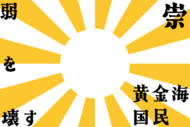
Near the end of the decade, Alstin entered into its own economic depression after the other economic powers had recovered from their own. Given the economic ties Ogonkai had with Alstin, the aftershocks of this economic depression hurt its economy and especially damaged its industrial sector, temporarily halting its growth. The crisis would continue until 1933 with the appointment of Masamoto Saga as secretary of the Economy. Saga had previously served as the head of the economics department of the Ogonkan embassy in Alstin, and emulated much of the reforms and economic programs of Alstin's Dawes Plan. Such programs included stimulating demand by initiating public works projects and controlling the budget deficit by using the Bank of Ogonkai to control inflacionary pressures.
Saga also proposed slashing the military budget and redirecting it towards other sectors of the economy such as infrastructure and agriculture. In a narrow 7-5 decision, the 1934 budget for Ogonkai's military was halved. This caused considerable uproar within the high ranks of the military that culminated in the Uprising in Sugihara. While Saga (who was visiting family) was assassinated during the fighting, the uprising was crushed by sectors of the military loyal to the government and its perpetrators were executed. The failed uprising resulted in the creation of the Shinchoheidan (Ogonkan: 慎重連隊), a secret police corps that engaged in espionage against the army and acquired intelligence on other sectors of the army that were planning to follow up on the uprising. The ensuing crackdown, in essence, rebuilt the higher ranks of the army as many were accused of treasonous activity and executed. This action significantly diminished the military's long standing influence within the government and enabled more civilian representation. It also saw the beginning of Sokubatsu (newly-formed business conglomerates and the oligarchic upper class that controlled them) influence in government.
The start of the Second Great War saw a significant shift in how Ogonkaic foreign policy conducted itself. The war saw an even bigger uptick in demand for resources, yet foreign secretary Michihara Taiha conducted a policy of increased diplomatic connection with its economic allies (chiefly Alstin, Cartadania, and Pelaxia) in order to assure stable economic relations that would not change no matter those countries' foreign policy. Because of this, Ogonkai supported the allies throughout the war but only economically; it never formally declared war against any of the anti-Levantine combatants, thus it avoided combat with military powerhouses like Daxia.
The post-war period (1943-1973)
The end of the Second Great War brought with it an age of continued economic growth that fully healed the economy from the turbulent decade that preceded it. It also brought a rush of foreign capital from all over the world and the replacement of Kinhara as Ogonkai's most influential city by Minakyo; the limited size of the island of Kinhara limited its growth and national and international corporations began settling in the port city of Minakyo instead. In 1948, Minakyo's GDP surpassed Kinhara's for the first time. After the war, foreign secretary Taiha secured many deals with Cartadanian, Pelaxian and Tierradoran companies to open branches in Minakyo. This was a major boon to Ogonkai's economy and the country quickly became a hotspot for technological and industrial development within Audonia.
During this time, Ogonkai also began to make a name for itself as an exporter of popular culture. The Occidental masses were introduced to Ogonkaic animation, comics, cinema, and music; recognition that was bolstered thanks to foreign secretray Taiha's actions to proactively introduce culture through other nations through cultural fairs and other events. Consequently, the cities of Kinhara, Minakyo and Yamatake became cosmopolitan hotspots and were among the fastest growing cities in the world at the time.
Ogonkai's urban population consolidated during this time; migration from the rural scapes to the cities reached peak levels in 1965, creating a demographic crisis from the abandonment of the fields that culminated in a recession in 1967. As a reaction, the government created various programs to incentivize more even demographic flows and incentives for development within rural communities. This also saw the beginning of the Ogonkaic government's long-standing policy towards migrant populations: that they ought to settle in less populated areas instead of the major cities.
Rentai revolution and present day (1974-)
The initial signs of a growing discontent within the Ogonkan population showed themselves in 1969. In a period known as the Lost Lustrum, the recession continued to slowly damage the country's economy and the Royal Council was in a constant gridlock, with all votes on proposals to alleviate the economic downturn consistently ending in 6-6 ties. Ogonkan youth articularly was affected by the recession: the job market had dried up, which confounded already existing issues of rising tuition costs and rising living costs more generally. Within the population began to emerge the thought that Ogonkai was falling behind the times of a period of increased liberalization and successful social movements, igniting century-old labor tensions and beginning the Rentai Revolution (Ogonkan: 連帯革命) against the monarchies with the ultimate aim of replacing the monarchies, thought of as stagnant and as a relic of a bygone era, with a popularly elected government.

The protests began in 1974 as spontaneous student movements in the major cities gathered mass support and different labor unions joined, causing the protests to rapidly swell in size. Inexperience with mass protests and a lack of coordination within police forces resulted in numerous clashes that rapidly began to turn deadly; in Yamatake alone, protests escalated to multiple city-wide riots after the regional police opened fire on a group of protesters. As other cities began to be consumed by the violence and police counter-violence, the social conflict intensified and by August 1974 all of Ogonkai's major cities were the grounds of violent confrontation between the police and protesters.
Other nations soon reacted to the increasing violence. Of most importance were Alstin, Daxia and Thervala; the three countries each supported differing sides within the protests. As the violence reached its peak in October with all-out armed firefights between protesters and police, three blocs of protesters began to form; the liberal protesters who wanted to replace the monarchies with a democratic, federal republic, the nationalists who wanted a more centralized and stronger state and the communists, who were part of the decade's emerging pan-Audonian communist movement. As the monarchy's international legitimacy weakened, discussions began to emerge on who was to take leadership of the movement; Alstin gave logistical, diplomatic and economic support to the liberal protesters while Daxia attempted to supply weapons to the nationalist protesters but was intercepted and nonetheless continued funding them. Thervala, then controlled by a military council, attempted to host peace talks between the nationalist sector and the monarchy to form a new government but failed in its attempts. The communist group began to gradually fizzle out in October thanks to low support by the populace resulting in the liberal and nationalist sectors taking the lead in the race for the leadership of the government. Infighting between the communist group dealt a final blow to the momentum it had acquired and it soon splintered to several minor factions with virtually no weight within the movement.
By November, it was the opinion of the military higher-ups that the monarchy would fall and Defense secretary Hikomoto Kuroki ordered the troops to stay in their quarters and suppressed the pro-monarchic factions that had arisen. In 16 November, one day before the 283rd anniversary of Ogonkai's founding, protesters stormed the Royal Council's palace in Kinhara. After the Royal Council stated that it would not back down and requested Thervalan military aid to quell the uprising, Alstin responded by issuing an economic embargo against Ogonkai, and Daxia announced it would execute a military operation if "the decree the Ogonkan people have put forth is trampled on". This virtually destroyed the monarchy's prospects of staying in power, and all of Ogonkai's monarchs stepped down, committed suicide, or fled to Thervala by 20 November.
The first government to be formed was a liberal-nationalist coalition with representatives of the twelve regions, with the nationalists gaining the backing of Defense secretary Kuroki. The military let the new government draft a Charter with the requirement that it make the military less dependent on the government. The government, represented by liberal Morikatsu Iwasaki and nationalist Yoriari Tozawa agreed; the Charter of Solidarity was finalized in late November and was ratified by the Provisional National Council and all of the Regional Councils in 1 December.
Alstin removed its embargo on Ogonkai in 2 December and although the economy was in bad shape, with an estimated Ȼ270 billion in damages, programs put forth by the provisional government quelled the economic instability. The government created the Institute of Trade and Industry (ITI), with the responsibility of estimulating economic growth by ensuring close cooperation between the government and national industry. It successfully promoted manufacturing and encouraged exports, returning Ogonkai to its place as a competitive exporter of manufactured goods. Other factors that influenced Ogonkai's technological rise were the use of techniques from the Occident and close economic cooperation with Alstin. By 1978, the economy returned to its pre-revolution level. The 80s saw the rise of Ogonkai as a world-class producer of electronics and automobiles; companies like Shomen! expanded and began to compete with Occidental technological companies like Palmtree Electronics in the field of electronics.
The first elections to decide the new government were held in 1 December 1975, one year after the proclamation of the current Charter. The first government, tied 5-5 between the liberal Ogonkai Democratic Party and the nationalistic Democratic Progress Party with the addition of the regional Iwanobe Prospers and Fukugan Convergence parties ensured a stable and democratic foundations for the newly-formed government. By the turn of the millennium, Ogonkai wrestled with the aftershocks of the ensuing Thervala economic implosion that precipitated the Ther migrant crisis. In 2016, a series of underground tunnels that connected all of the country (including the island prefectures of Shimakoshi, Ryokuya and Okusen), were completed and the state-backed but privately-run Ogonkai Rail was formed, tasked with administrating the national railway system. Beginning in 2020, the Democratic Progress Party-led government significantly shifted government funding towards the military in order to meet increased tensions around the world as a result of the Final War of the Deluge. As of 2037, the Council is led by a coalition of the Democratic Party and the Iwanobe Prospers party.
Geography
-
A beach in Seiha prefecture
-
Snowy peaks in Fujisato prefecture
-
Rolling mountains in Hakusan prefecture
-
Kinfurei trees against a mountain in the western special territory
-
Historical district of Senkawa, now a part of Yamatake
-
Minakyo Bay
The majority of Ogonkai's terrain is rugged and mountainous, disencouraging population growth. Nonetheless, it has a variety of landscapes.
Climate and environment
While temperate in its most inhabited areas, it varies considerably between north and south. Most of the country has a humid continental climate.
Government and Politics
The politics of Ogonkai take place within the framework of the 1974 Charter of Solidarity. Article 1 establishes the fundamental, inalienable principles and aims of the State: "The defense of dignity, the defense of liberty and the march towards eternal happiness and prosperity under the guide of each of the Council's twelve prefectures that shall work together to achieve the aims of the State". The Charter establishes the right of independence of all the prefectures, and accordingly devolves powers from the central government to the prefectures. It is hard to define if Ogonkai is a federal state or a confederation; many faculties that are undertaken by a central government in a federation, such as legislative faculties, are undertaken by the prefectures. However, the central government is not subordinate to the member states, as is the case for confederations.
Executive
Power is jointly exercised by the National Council, a college of heads of government that hold equal power. It is a custom that the eldest member of the Council is its representative, and thus acts as the country's head of state. The National Council directs the policies of the federal government and names the twelve members of Ogonkai's cabinet, similar to presidential systems of government. The President of the Council is an uncodified, informal position, although it is a custom for the eldest member of the council to exert the presidency. Nonetheless, the president is still just a first among equals with no additional responsibilities or duties other than ocassionally representing Ogonkai in international affairs.
Legislative
Ogonkai lacks a national legislature, but the citizens of each prefecture vote for the composition of their Prefectural Council, a legislative body that in turn elects its representative for the National Council. Each Prefectural Council is made up of 51 members serving a period of 4 years and is unicameral. The makeup of each Prefectural Council is decided by a system of proportional representation. In addition to being able to draft and approve laws for their own prefecture, each council may submit their approved laws to be voted on by the National Council to become federal laws. Some laws, as well as any proposed amendments of the constitution, may be submitted to the Supreme Tribunal of Ogonkai which decides if it can be submitted to the National Council. While extraordinarily rare, some current laws as well as amendments have been passed this way; the 2004 amendment that gave the Special Territories observer status within the National Council was passed this way.
Federal subdivisions

Ogonkai is a federal country with 12 prefectures and three special territories ruled directly by the National Council. The prefectures are federated states, and they have a degree of self-governance higher than most other countries' subdivisions. Under the Charter, all prefectures are equal and are to be represented equally in the National Council no matter their population; voters every four years vote on the composition of their Prefectural Council, which elects the prefecture's Minister. the Minister is in charge of managing the prefectural government.
Ogonkai also features three Special Territories (特区, Special Districts); these are the Western, Central and Eastern territories. They have no self-governance and no permanent seat in the National Council, although they have had observer status since 2004. They are overseen directly by the federal government of Ogonkai. The Special Territories lag behind the prefectures in social and economic development; they have, by a wide margin, the biggest rates of poverty and homelessness in Ogonkai.
They are a frequent source of instability within Ogonkai, as a lack of government oversight has given rise to activity by Ther organized criminal factions that control vast swathes of the uninhabited desert. Since 1967, the government of Ogonkai has installed a policy wherein migrants from other countries are barred from entering the prefectures unless they live in the Special Territories for 10 years; although the aim has been to alleviate the burden caused by urban growth and to develop the Special Territories, in practice it has confined the bulk of migrants to these unsafe and dangerous places. Since 2000, the Special Territories have drastically swelled in population due to the Ther migrant crisis, intensifying conflict within the Eastern Special Territory and neighboring Iwanobe prefecture.
Politics
Politics in Ogonkai are dominated by the 1974 System, a term used by scholars that refers to the two-party system between the Democratic Progress Party and the Democratic Party. Both parties have formed part of all of the councils since the beginning of Ogonkai's republican era; modern Ogonkaic history has been largely defined by the interactions of these two parties. The Democratic Progress Party and the Democratic Parties trace their origins back to the larger student groups that emerged during the Rentai Revolution and were in charge during much of the economic prosperity that happened afterward, which gave them a solid foundation through which they formed several tightly-knit relationships with different sectors of society, chiefly the business and middle class sectors.
Demographics
Ogonkai has a population of 64 million, of which 59 million are Ogonkan nationals. Ther nationals consist of approximately a million people, while Daxians, Kandarans and other foreign nationals and their descendants make up the remainder. It is estimated that up to 6 million Ogonkans have Ther ancestry, but accurate figures are hard to acquire given most of them have been assimilated into Ogonkaic society. Assuming current demographic trends continue, Ogonkai is projected to reach a peak population of 90 million in 2070 from where it will slowly drop. By 2030, approximately 97% of Ogonkans lived in cities, making Ogonkai the most urbanized country in the world. This lack of activity in the interior of the country has long crippled Ogonkai's agricultural industry, and has forced the country to be an importer of foodstuffs and other materials.
Language
Ogonkaic is enshrined as the only official language nationwide and all government institutions must prominently communicate in Ogonkaic. Given Ogonkai's long-standing cultural links with Alstin, Blairian Ænglish is the primary variant of Ænglish spoken in Ogonkai. This language has become increasingly important as the default language for business and communication with foreign citizens, and as a result, it has been national policy since 2005 to teach Ænglish at all schools in Ogonkai. Iwanobe prefecture has enshrined the Ther language as a co-official language in the province since 2011 after the Supreme Tribunal allowed it to do so. There are a number of other minority languages spoken mainly by indigenous groups on the west of the country, but they are endangered as a result of the government's assimilation policy. One of such language is the Kana language, spoken by the eponymous tribes located in the west of the country; it is considered a moribund language and as of 2030 only has 60 speakers, all of whom are of old age.
The Ogonkaic language has two main dialects; standard and insular. Insular Ogonkaic is spoken in Shimakoshi prefecture as well as the north of Okasen prefecture. Most prominently, it incorporates aspects of medieval Ogonkaic. While previously it struggled as more and more of the youth spoke instead in standard Ogonkaic, recent efforts spearheaded by the prefectural governments of Shimakoshi and Okasen have given way to a renaissance in the dialect and its mass adoption by the inhabitants of these regions.
The last language of note is Ogonkaic-Ther hybrid language, a language that has arisen in recent times as a contact language that features a syncretic mix of the Ther and Ogonkaic languages. While it uses the Ogonkaic script, it notably diverges from the language in that it borrows the Ther language's subject-verb-object word order instead of standard Ogonkaic's subject-object-verb word order. It also features a plethora of loan words and differing phonetics from standard Ogonkaic. While it is not constitutionally enshrined in any prefectural constitution, regulatory bodies like the Institute of Ogonkaic-Ther Union Language have already been created, confirming its growth among the speakers of Iwanobe prefecture (especially among the youth and descendants of third-generation Ther migrants in Ogonkai) and hinting towards future prefectural or even national recognization of the language.
Religion
While Ogonkai's main religion is Azarashinen (海豹信念), its charter enshrines religion freedom as a right all prefectures must guarantee. Chantric is the largest religious minority. Another significant minority is Theravada and practiced mostly by Ther migrants and their descendants. Among Audonia, Ogonkai is one of the nations with the largest percentage of non-believers; more than 20% of the population calls itself atheist or agnostic. Smaller minorities include Protestantism, mainly practiced by Occidental expacts and some isolated communities in some prefectures.
Culture and Society
Ogonkai's contemporary culture combines its own indigenous culture with that of the Occident (most notably, Alstin, Tierrador and Pelaxia). Traditional Ogonkaic arts include swords, ceramics and flower arranging. However, since the arrival of the occidentals Ogonkai has had notable output in the domain of literature as well. Ogonkai has many cultural sites that are classified as National Treasures. Beginning in the 1980s, Ogonkai's popular culture has taken center stage as the most dominant form of culture present in the country. Owing to the global popularity of its cultural output, Ogonkai is considered a cultural superpower.
Education
Ogonkai's education system is highly robust, although it varies greatly from region to region.
Cuisine
Ogonkai's main attractive when it comes to cuisine is its regional variety.
Religion
Religious affiliations in the XXX (20XX)
Ogonkai's Charter enshrines religious freedom as a right of all citizens of Ogonkai.
Arts and Literature
Ogonkai is reknown for its popular culture, specifically its videogames and animation.
Sports
Ogonkai's most popular sports are baseball, association football.
Economy and Infrastructure
Ogonkai's economy is mostly privately operated, although the state exerts great influence.
Industries and Sectors
Ogonkai's economy is dominated by the service and manufacturing industries.
Healthcare
Healthcare in Ogonkai is state-run.
Labor
Labor unions in Ogonkai, while technically protected under the Charter, are frequent targets of broad-strokes laws regarding 'disorderly conduct'.
Transportation
Ogonkai has a highly advanced rail transport system.
Energy
Ogonkai, given its lack of fossil fuels and coal, has been forced to be a pioneer in renewable and nuclear energy.
Technology
Ogonkai is a technologically advanced country, being at the forefront of technological developments.
Military
Ogonkai's military is passable, but not exceptional.
- ↑ While the current Charter establishes that there is no capital city, both the National Council and Supreme Tribunal are headquartered in Kinhara.
- ↑ Ogonkai's current Charter establishes that while the prefectural and federal governments and their institutions are secular, the State recognizes the Azarashinen religion as an important cultural institution, and protects it.


